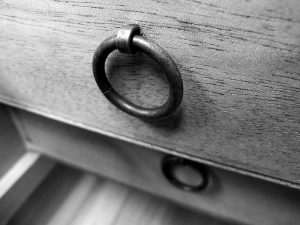We may receive a commission when you use our affiliate links. However, this does not impact our recommendations.
One of my first orders from the Lee Valley Tools catalog was for a big supply of these traditional ring pulls. I love this fastener for so many reasons. It is inexpensive. It looks great. It is made in Italy. It works with a wide variety of furniture styles, from Japanese tansu to contemporary.
But it is not easy to install.
Indeed, since 1996 I have received dozens of pleas from readers asking how to install this pull. They have offered me money, fame and wheels of fragrant cheese.
I have always declined. After all, I spent four years in the octagon of hardware installation, learning the right way to wield the hammer and the needlenose pliers. I studied the subtle twist of the putty knife under master Lee. I practiced the gentle way to push the nubbin of the steel staple into its perfectly sized hole under the third son of the founder of Shotokan, whom we call Giko.
And now I give this to you.
With banjos.
— Christopher Schwarz
Here are some supplies and tools we find essential in our everyday work around the shop. We may receive a commission from sales referred by our links; however, we have carefully selected these products for their usefulness and quality.









Hi Chris, what hammer do you use in the video?
Chris, what size pull did you use for your tills?
Thanks
The Lee Valley website suggests that the traditional ring pulls may be installed using only a hammer (or a rock). I noticed that you used pliers to bend the prongs…is there a chance you are installing the hardware incorrectly? Suppose someone were to use a rock, in lieu of a hammer for the installation. What size/shape rock would you use?
So what’s the music? Please tell.
I installed one on the drawer in our powder room that was very similar to yours. I found it laying in the drawer when we bought the house. I guess the former owner didn’t want to put it on. I used a pair of linesman’s pliers though. I prefer brute force.
As after other things that generate extreme pleasure, watching you install that pull and listening to that banjo, I need a cigarette…
Strictly speaking, it would be “with banjo,” rather than “with banjos.”
And besides, it’s a tenor banjo, which hardly counts.
-Steve
Kind’a funny that this post reads a little different on my Google mobile app. The video does not show, so it appears that the complete answer on installation is that it is done “with” banjos.
After a quick search on different models of Banjo, I was leaning towards ordering the “Clawhammer” banjo vs. the better known “Dixieland”,and “Bluegrass” models.
Thanks for the video Chris. It makes much more sense now!